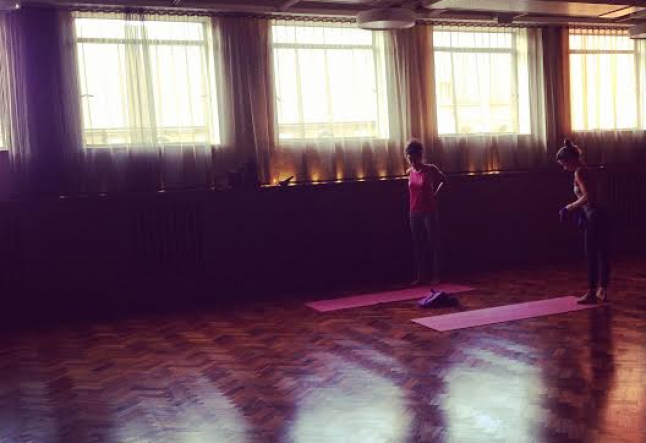designing a yoga class

the art of teaching
When entering a yoga studio, there are a few things, which make a big difference between a teacher-student relationship. One of the most important things when it comes to human interaction is the predisposition you have towards others- making contact with your students, who have left their busy schedule to attend your class and bring their energy to share it with you. Most of them don’t even reailze that this is what they really come for, until Savasana comes up. For that reason, it is extremely important to talk to and encourage your students to perform better even if they have had a “stressfull or bad day”.
What makes a good yoga practice is the attitude you put in every single movement
Promote a quiet and peaceful beginning of the class with a meditation or relaxation. Kindly ask those students who come a bit late to place the Yoga mat on the floor without interrupting their Yogi colleague.
Meditation while teaching… while learning.
Focus on the every part of your body and be grateful for it. Feel your breath… feel your energy… feel who you are. Notice what happens to your mind on the out breath. Do you have any resistant to empty your lungs? Any resistant to let your breath go completely?… observe the quality of your inhalation and exhalation. Concentrate for a few minutes in releasing the tension accumulated in the upper chest, ribs cavity and thorax, and let everything go… relax completely. Even the tiny muscles in your face are relaxed.
Recently, I was given amazing instructions that I would like to share with all of you in this article
The following steps help to create a progession of instructions that creates clarity for teacher and student, and promotes a safe experience for the student. Be sure and construct each pose systematically from the foundation up (this approach is referred to “krama” or “wise progression”). Pausing to see how your students are doing, so you can offer clearer instructions if necessary with modifications, adaptations and alternatives.
1. Finding the breath
2. Establishing the foundation
3. Feeling & Emphasizing the energy and integration of the spine and pelvis
4. Giving specific instructions
5. Applying your personal teaching tools
Breathing has been a great learning in my own practice. I am now aware of how and when I breath!. Breathing is one of the few bodily functions, which within limits, can be controlled both consciously and unconsciously. I strongly agree that human beings are so disconnected from this important system. Learning, practicing and teaching how to properly use Ujjayi breath has been outstanding and relevant to me. I have found quality in my transitions and ease in my balances just by controling my breath. To see how my students are able to feel the benefits of my teaching has been very rewarding.
A completely different world opens up to me when I discover the foundation of each pose, the foundation of a Yoga body. My idea of a perfect asana has vanished bringing a new concept of safe and stable asana. Teaching and building my class with a good foundation is a key point in my methodology as a good teacher. By creating a deep connection with my mat, I have discovered the sense of feeling grounded not only when practicing Yoga but also in my daily routine. A sense of calmness and steadiness arises when walking consciously. Even with a heavy pair of boots, if I pay attention to how am I walking, how my arches are flattening or lifting and how my lower back and spine are positioned, I notice an unexplained feeling of attraction with the earth, with the ground I am stepping on. I hadn’t felt this before I started learning the importance of a good foundation.
Similarly occurs with the spine. I have always been very conscious about lifting and lengthening my spine but for many years I suffered from lower back pain. When I started doing Yoga, especially after my training, gradually my back pain was disappearing. I learnt not only how to lengthen and lift the spine but also how to correctly position my shoulders, pelvis and core (then I discovered Yogi diamond). I have observed many classes as part of my training and I still enjoy sometimes sitting down at the back of the room observing bodies. Watching how they express freely by their movements and how good a teacher’s instructions can drastically change someone’s alignment. Having a healthy spine position can even change your mood.
Clear and specific instructions are very important in a Yoga class, especially in beginners levels. Beginners tend to copy every single movement. As a yoga teacher you can’t always practice at the same time as your students; you need to observe, assist, talk, demonstrate, and breath! All in one. This is why using clear instructions in a yoga class are so important for beginners to be able to follow you. On the other hand, using too many alignments or instructions could block a student’s mind, so they end up having too much information, which they can’t process.
I believe a good yoga teacher develops him or herself with their own experience, practice, dedication and improvisation. I am gradually filling my bag of yoga tools with my teacher’s advise, my own observations, readings, and just letting my brain absorb as much as I can. Gradually, I am developing my own way of teaching. A completely different way than my other colleagues, teachers or Yoga Masters. This is why yoga is so exciting.
It has been (and it still is) very time consuming. Dedication, organization, discipline and constancy are just a few of the most important aspects I have developed and nurture in my yoga journey. Passion, patience, knowledge and acceptance are also inevitably always there.
Read next >> yoga and the law of attraction